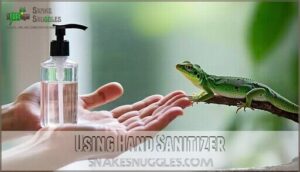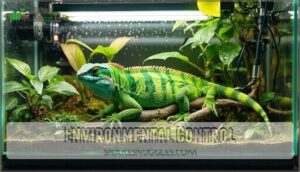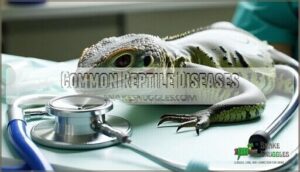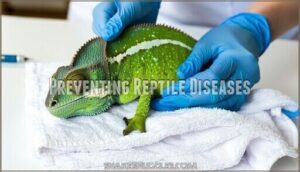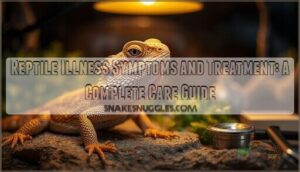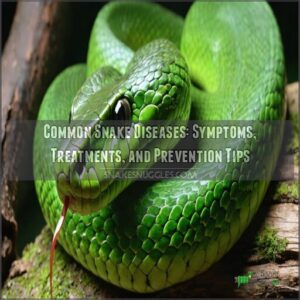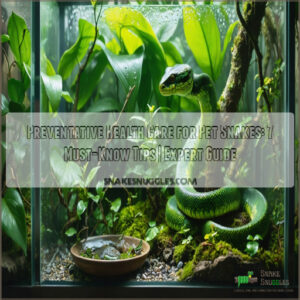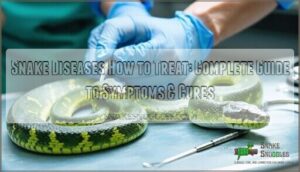This site is supported by our readers. We may earn a commission, at no cost to you, if you purchase through links.
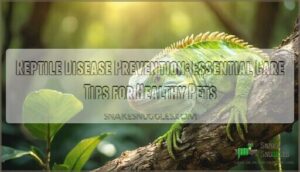
Always wash your hands thoroughly after handling your pet, their food, or habitat items, as reptiles naturally carry bacteria like Salmonella.
Maintain ideal temperature and humidity levels in their enclosure, provide species-appropriate diets, and schedule regular veterinary check-ups to catch health issues early.
Keep their environment clean by removing waste promptly and disinfecting surfaces regularly, and watch for warning signs like changes in appetite, lethargy, or unusual behavior patterns, which can help you spot potential problems before they become serious health concerns through smart prevention strategies.
Table Of Contents
- Key Takeaways
- Reptile Health Risks
- Safe Handling Practices
- Reptile Care Essentials
- Common Reptile Diseases
- Preventing Reptile Diseases
- Frequently Asked Questions (FAQs)
- What should I do if my pet eats a reptile?
- How do you care for a pet reptile or amphibian?
- How do I prevent parasitic infestations in my reptiles?
- How do you keep reptiles healthy?
- How to prevent respiratory infections in reptiles?
- Do reptiles have health issues?
- How to prevent parasites in reptiles?
- How do you prevent metabolic bone disease in reptiles?
- How to keep reptiles healthy?
- How to prevent Salmonella from reptiles?
- Conclusion
Key Takeaways
- Wash your hands thoroughly after handling reptiles, their food, or habitat items – scrub for at least 20 seconds with soap and warm water to prevent Salmonella transmission to you and your family.
- Maintain proper habitat conditions by keeping ideal temperature gradients, humidity levels, and cleanliness through daily waste removal and weekly substrate changes to prevent respiratory infections and skin diseases.
- Schedule regular veterinary check-ups every 6-12 months since reptiles hide illness signs until conditions become severe – early detection saves lives and prevents costly complications.
- Monitor your reptile daily for behavioral changes like lethargy, appetite loss, breathing difficulties, or unusual postures, as these warning signs help you catch health problems before they become life-threatening.
Reptile Health Risks
You’ll face real health risks when keeping reptiles as pets, since they naturally carry harmful bacteria like Salmonella even when they appear healthy.
These germs can spread to you and your family through direct contact or contaminated surfaces, making proper care and hygiene essential for safe reptile ownership.
Salmonella Infections
When you bring reptiles home, you’re also welcoming Salmonella bacteria.
When you welcome a reptile into your home, you’re also inviting invisible bacterial hitchhikers along for the ride.
These microorganisms naturally live in your pet’s digestive system, even in healthy animals.
Salmonella transmission happens through direct contact with reptiles or contaminated surfaces.
Infection symptoms include fever, diarrhea, and stomach cramps.
Vulnerable groups like children under five face serious risks.
Proper hand hygiene prevents cross-contamination and protects your family from Salmonella infection.
Infants are particularly susceptible to indirect reptile contact, highlighting the need for vigilance.
Zoonotic Diseases
Beyond Salmonella, reptiles harbor various zoonotic diseases that spread through direct contact or contaminated environments.
These reptile vectors carry bacteria, viruses, fungi, and parasites that pose serious health risks.
Key zoonotic diseases include:
- Campylobacteriosis – causes diarrhea and fever within 2-5 days
- Mycobacterium infections – lead to skin and soft tissue problems
- Leptospirosis – spreads through urine contact, causing flu-like symptoms
- Pentastomiasis – life-threatening parasitic disease from reptile meat consumption
Prevention strategies center on strict hand hygiene and following CDC guidelines for disease transmission control.
Reptiles can also transmit Salmonella via feces, so caution is needed.
Vulnerable Populations
Children under 5, adults over 65, and immunocompromised individuals face higher risks from reptile-related infections.
Certain groups need extra protection when reptiles are around—their immune systems can’t handle what healthy adults might easily fight off.
Pregnancy concerns include potential complications from Salmonella** exposure. Childrens immunity systems can’t fight off infections as effectively.
Elderly risks increase due to weakened immune responses. Immunocompromised care requires extra preventative measures when handling pet reptiles to prevent serious illness.
Preventing Cross-Contamination
Cross-contamination spreads germs from reptiles to family areas. Keep reptile supplies separate from household items. Store food in designated containers away from human food.
Use separate sinks for cleaning equipment and dispose of waste properly. Proper handwashing prevents salmonella infections.
- Use designated supplies only for reptile care – never mix with kitchen items
- Clean reptile equipment in separate sinks like laundry rooms or bathrooms
- Wash clothing exposed to reptiles immediately using hot water and detergent
- Dispose of habitat wastewater down toilets, not kitchen or bathroom sinks
Safe Handling Practices
Safe handling practices protect both you and your reptile from disease transmission and injury. You’ll need proper techniques for handwashing, sanitizing, supervising children, and avoiding bites to maintain everyone’s health.
Handwashing Techniques
After handling reptiles, wash your hands with effective soap and warm water for at least twenty seconds.
Focus on scrubbing under your nails where germs hide, and use proper drying methods using clean towels to complete the process.
This consistent hygiene routine is your best defense against Salmonella and other bacteria, as thorough hand washing beats sanitizer efficacy for reptile disease prevention every time.
Using Hand Sanitizer
When soap and water aren’t available, hand sanitizers with at least 60% alcohol percentage provide effective sanitizer alternatives for reptile hygiene practices.
Apply sanitizer thoroughly, covering all hand surfaces for proper application technique.
Higher alcohol percentage increases sanitizer effectiveness against germs that cause reptile illness.
Hand sanitizers support reptile disease prevention and maintaining reptile health through consistent reptile hygiene practices.
Supervising Children
Young ones need your watchful eye when meeting reptiles. Their natural curiosity can lead to risky situations without proper guidance and oversight.
- Teach proper handwashing techniques – Show kids how to scrub for 20 seconds after reptile contact
- Monitor all interactions closely – Stay within arm’s reach during handling sessions
- Explain age-appropriate safety rules – Use simple language about Salmonella risks and hygiene education
- Supervise hand sanitizer use – Prevent accidental ingestion while ensuring safe interaction protocols
Parental oversight protects children’s safety while building their confidence with reptile disease prevention habits.
Avoiding Bites and Scratches
Reptile bites can catch you off guard, but proper handling techniques and the right tools make all the difference.
Use handling tools like snake hooks and tongs for venomous species, ensuring safe restraint without direct contact.
Learn proper bite prevention through calm approaches and gentle support, and keep first aid supplies nearby for immediate wound care.
Always practice hand washing after any reptile contact, regardless of your owner experience level.
Reptile Care Essentials
Creating a healthy environment for your reptile requires consistent attention to several key factors that directly impact disease prevention.
When you maintain proper habitat conditions, provide balanced nutrition, control environmental variables, and minimize stress, you’re building a strong foundation that helps your pet resist common health problems, based on the concept of creating a healthy environment for your reptile.
Proper Habitat Maintenance
Five essential steps keep your reptile’s home clean and disease-free. Daily spot-cleaning prevents bacterial buildup while proper substrate selection guarantees easy waste removal. Maintain temperature gradients and humidity control through regular monitoring.
Selecting the right reptile bedding options is vital for their health. Here’s your habitat maintenance checklist:
- Daily Waste Removal – Remove feces and uneaten food immediately
- Weekly Substrate Changes – Replace bedding to prevent contamination
- Monthly Deep Cleaning – Disinfect enclosure with reptile-safe solutions
- Equipment Sanitization – Clean water bowls, decorations, and tools regularly
- Environmental Monitoring – Check temperature and humidity levels daily
Balanced Diets
Through proper nutrition, you’ll prevent most reptile nutritional deficiencies and metabolic diseases.
Offer prey variety—insects, greens, fruits—tailored to your species’ needs.
Supplementation needs include calcium 2-3 times weekly and vitamin D3 for bone health.
Gut-load feeder insects 48-72 hours before feeding.
A balanced diet with proper hydration importance prevents nutritional disorders effectively.
Monitor environmental temperature gradients to confirm proper digestion and overall health.
Environmental Control
Creating the right environment is like setting up your reptile’s personal climate zone.
Temperature gradients let your pet choose their comfort level, while proper humidity levels prevent respiratory issues and skin problems.
Full-spectrum lighting cycles support calcium metabolism and natural behaviors.
Choose substrates that balance comfort with easy cleaning.
Adequate enclosure size reduces stress and disease risk through proper environmental control measures.
Maintaining stable conditions often requires specialized reptile supplies to ensure a healthy and thriving pet with proper humidity levels.
Stress Reduction Techniques
Stress affects your reptile’s immune system, making them vulnerable to infections and diseases.
Smart environmental enrichment and consistent care routines keep stress levels manageable.
Here are four key stress reduction techniques:
- Create hiding spots using caves, logs, or commercial hides to provide security
- Maintain temperature gradients with basking and cool zones for thermoregulation
- Reduce noise levels by placing enclosures away from high-traffic areas
- Limit handling frequency to species-appropriate intervals, not daily interaction
Environmental enrichment through varied substrates, climbing structures, and feeding schedules mimics natural behaviors.
Consistent care routines help reptiles feel secure in their safe environment.
Common Reptile Diseases
Understanding common reptile diseases helps you protect your pet’s health and catch problems early.
Respiratory infections, digestive disorders, skin infections, and septicemia represent the most frequent health challenges that reptile owners face, including respiratory infections.
Respiratory Infections
Looking at respiratory infections in reptiles, poor husbandry creates the perfect storm for disease.
When temperatures drop or humidity spikes, your reptile’s immune system weakens, making them vulnerable to nidoviruses and mycoplasma.
Watch for wheezing, open-mouth breathing, and nasal discharge – these symptoms signal trouble.
Treatment requires antibiotics and supportive care, but prevention through proper environmental control beats dealing with complications later.
Respiratory infections spread quickly through collections, so early detection saves lives.
Digestive Disorders
Your reptile’s digestive system faces threats from viral infections, bacterial overgrowth, and parasitic infections that can quickly turn serious.
Gastrointestinal blockages from poor diet choices and nutritional deficiencies weaken your pet’s defenses.
Cryptosporidiosis causes severe weight loss, while adenoviruses prove fatal in young bearded dragons.
Reptile disease prevention requires proper feeding protocols and veterinary care for ideal reptile health. Maintaining proper temperature regulation is also essential for healthy digestion.
Skin Infections
Bacterial dermatitis and fungal infections plague reptiles housed in dirty, humid environments.
You’ll spot swollen, pus-filled lesions that can quickly spread without proper treatment.
Parasitic mites cause constant irritation, while shedding problems create open wounds for bacteria.
Clean habitats prevent most skin issues, but abscess treatment requires veterinary intervention to avoid life-threatening complications, including the risk of complications.
Septicemia
When blood bacteria overwhelm your reptile’s immune system, septicemia becomes a life-threatening emergency.
This deadly condition often stems from reptile trauma, environmental stress, or poor husbandry practices.
Septicemia symptoms include lethargy, respiratory distress, and purple skin discoloration on the belly.
Quick antibiotic treatment can save your pet’s life, but prevention through proper care remains your best defense against this serious reptile bacterial infection.
Preventing Reptile Diseases
You can prevent most reptile diseases through consistent care and early detection.
Regular veterinary check-ups, proper habitat maintenance, and daily health monitoring will keep your scaly companion healthy and reduce the risk of serious illness, ensuring consistent care and early detection are key to a healthy pet.
Regular Veterinary Check-Ups
A proactive approach to reptile veterinary care builds the foundation for long-term health success.
Schedule routine checkups every 6-12 months, as reptiles often hide illness signs until conditions become severe.
- Early Detection – Annual health screenings catch diseases before symptoms appear
- Preventative Care – Vaccinations and treatments prevent common illnesses from developing
- Health Monitoring – Weight tracking and physical exams identify subtle changes
- Parasite Screening – Regular fecal tests detect internal parasites early
- Husbandry Review – Veterinary care plans include habitat assessments for ideal conditions
Maintaining Clean Environments
Clean habitats prevent disease outbreaks effectively.
Daily waste removal and proper substrate selection create healthier environments for your reptiles.
Maintain water quality through regular changes and filtration systems.
Follow strict disinfection protocols using reptile-safe cleaners for enclosure cleaning.
Clean enrichment items weekly to prevent bacterial buildup.
Consider using a reptile habitat cleaner to maintain a sanitary environment.
Consistent habitat sanitation and pet disinfection practices keep snake enclosure cleanliness at its best.
Monitoring Reptile Health
Daily monitoring reptile health involves watching for behavioral changes, weight fluctuations, and irregular shedding patterns.
You’ll spot early warning signs through consistent animal observations and routine physical exams.
Track eating habits, activity levels, and waste output for thorough health screening.
Regular fecal analysis helps identify parasites, while recognizing disease symptoms early enables prompt veterinary guidance when needed, which is crucial for overall reptile health.
Providing Optimal Care
To provide ideal care for your reptiles, you’ll need to master species-specific needs and create engaging enrichment activities.
Proper reptile health management requires behavioral observation and responsible ownership practices.
Implement quarantine protocols for new arrivals to prevent disease spread.
Focus on reptile disease prevention through consistent care routines that support your pet’s natural behaviors and physical requirements.
Recognizing Disease Symptoms
Early detection saves reptile lives by catching illness before it becomes critical.
Watch for behavioral changes like lethargy signs, appetite loss, and increased hiding. Breathing difficulties, skin abnormalities, and unusual postures signal trouble.
Monitor your pet daily since reptiles often mask disease symptoms until advanced stages require immediate veterinary care.
Regular cleaning helps with reptile disease prevention, which is crucial for reptile disease prevention and can aid in early detection.
Frequently Asked Questions (FAQs)
What should I do if my pet eats a reptile?
Monitor your pet closely for symptoms like vomiting, diarrhea, or lethargy.
Contact your veterinarian immediately if these occur.
Reptiles can carry Salmonella and other harmful bacteria that may cause illness in pets.
How do you care for a pet reptile or amphibian?
Six percent of human salmonella infections come from reptile contact, so you’ll need proper hygiene practices.
Wash hands after handling, maintain clean habitats, provide appropriate lighting and temperature, feed balanced diets, and schedule regular veterinary checkups for health monitoring.
How do I prevent parasitic infestations in my reptiles?
Quarantine new reptiles for 30-90 days before introducing them to your collection. Schedule regular fecal exams with an exotic veterinarian, maintain proper hygiene, and keep enclosures clean with appropriate temperatures.
How do you keep reptiles healthy?
While sophisticated terrariums impress visitors, basic care fundamentals matter most: maintain proper temperatures, provide clean water, guarantee adequate UV lighting.
Feed appropriate diets, keep habitats clean, and schedule regular vet checkups for peak health.
Ensure the overall environment supports the well-being of the terrarium’s inhabitants by following these basic care fundamentals.
How to prevent respiratory infections in reptiles?
Maintain proper temperature gradients, humidity levels, and ventilation in your reptile’s enclosure. Clean environments regularly, avoid drafts, and guarantee adequate heat sources to prevent respiratory infections.
Do reptiles have health issues?
Like a fragile ecosystem where balance determines survival, reptiles face numerous health challenges that’ll test your caregiving skills.
Yes, reptiles definitely have health issues.
They’re susceptible to respiratory infections, digestive problems, skin diseases, septicemia, and viral infections like adenovirus, requiring proper care.
How to prevent parasites in reptiles?
Keep your reptile’s environment clean by removing waste daily, quarantining new animals for 30-60 days, and scheduling regular vet checkups.
Proper hygiene and consistent habitat maintenance stop parasites before they start.
How do you prevent metabolic bone disease in reptiles?
You’ll prevent metabolic bone disease by providing full-spectrum UV lighting, offering calcium-dusted feeder insects, maintaining proper temperatures, and ensuring your reptile gets adequate vitamin D3 supplementation.
How to keep reptiles healthy?
Success in reptile care hinges on five key factors: proper lighting with UV bulbs.
Controlled temperature and humidity.
Balanced diets with supplements.
Clean habitats.
And regular vet checkups for early disease detection.
How to prevent Salmonella from reptiles?
Always wash your hands with soap and water after touching reptiles, their food, or habitats. Clean all surfaces they contact. Keep reptiles away from kitchens and food prep areas completely.
Conclusion
Successfully mastering reptile disease prevention transforms you from a worried pet owner into a confident reptile guardian.
Your diligent handwashing, thorough habitat maintenance, and sharp observation skills create an impenetrable shield against diseases that could threaten your scaly companion.
Regular veterinary visits and proper environmental controls guarantee your reptile thrives for years.
Remember, consistent reptile disease prevention practices protect both your pet’s health and your family’s safety through simple, effective daily routines.
- https://www.birdandexoticsvet.com/reptile-health-identifying-and-preventing-common-issues/
- https://srhd.org/health-topics/environmental-health/reptile-rules
- https://pubmed.ncbi.nlm.nih.gov/34366012/
- https://www.veterinary-practice.com/article/an-introduction-to-common-reptile-viral-diseases
- https://petkraze.com/blog/47004/common-reptile-diseases-and-solutions


